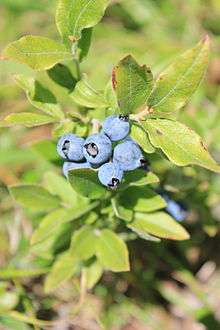Vaccinium myrtilloides
Vaccinium myrtilloides is a shrub with common names including common blueberry, velvetleaf huckleberry, velvetleaf blueberry, Canadian blueberry, and sourtop blueberry.[2] It is common in much of North America, reported from all 10 Canadian provinces plus Nunavut and Northwest Territories, as well as from the northeastern and Great Lakes states in the United States. It is also known to occur in Montana and Washington.[3]
| Vaccinium myrtilloides | |
|---|---|
 | |
| Scientific classification | |
| Kingdom: | |
| (unranked): | |
| (unranked): | |
| (unranked): | |
| Order: | |
| Family: | |
| Genus: | |
| Species: | V. myrtilloides |
| Binomial name | |
| Vaccinium myrtilloides Michx. 1803 | |
| Synonyms[1] | |
| |
Description
Vaccinium myrtilloides is a low spreading deciduous shrub growing up to 50 cm (20 inches) tall, often spreading to form small thickets. The leaves are bright green, paler underneath with velvety hairs. The flowers are white, bell-shaped, 5 mm (0.2 inches) long. The fruit is a small sweet bright blue to dark blue berry. Young stems have stiff dense bristly hairs.[3]
Vaccinium myrtilloides grows best in open coniferous woods with dry loose acidic soils; it is also found in forested bogs and rocky areas. It is fire-tolerant and is often abundant following forest fires or clear-cut logging. Vaccinium myrtilloides hybridizes in the wild with Vaccinium angustifolium (lowbush blueberry).
Characteristics
Vaccinium myrtilloides is also cultivated and grown commercially in Canada and Maine, mainly harvested from managed wild patches. Vaccinium myrtilloides is one of the sweetest blueberries known.
It is also an important food source for black bears, deer, small mammals, and birds.
Conservation Status in the United States
This species is listed as endangered in Indiana and Connecticut,[4] as threatened in Iowa and Ohio, and as sensitive in Washington (state).[5]
Native American Ethnobotany
As cuisine
The Abenaki consume the fruit as part of their traditional diet.[6] The Nihithawak Cree eat the berries raw, make them into jam and eat it with fish and bannock, and boil or pound the sun-dried berries into pemmican.[7] The Hesquiaht First Nation make pies and preserves from the berries.[8] The Hoh and Quileute consume the fruit raw, stew the berries and make them into a sauce, and can the berries and use them as a winter food.[9] The Ojibwa make use of the berries, gathering and selling them, eating them fresh, sun drying and canning them for future use.[10] The Nlaka'pamux make the berries into pies.[11] The Algonquin people gather the fruit to eat and sell.[12] The berries are part of Potawatomi traditional cuisine, and are eaten fresh, dried, and canned.[13]
As medicine
The Nihithawak Cree use a decoction of leafy stems used to bring menstruation and prevent pregnancy, to make a person sweat, to slow excessive menstrual bleeding, to bring blood after childbirth, and to prevent miscarriage.[7] The Potawatomi also use the root bark of the plant for an unspecified ailment.[14]
See also
References
- "Vaccinium myrtilloides". Tropicos. Missouri Botanical Garden.
- Michaux, Flora Borealis-Americana 1: 234. 1803.
- Vander Kloet, Sam P. (2009). "Vaccinium myrtilloides". In Flora of North America Editorial Committee (ed.). Flora of North America North of Mexico (FNA). 8. New York and Oxford – via eFloras.org, Missouri Botanical Garden, St. Louis, MO & Harvard University Herbaria, Cambridge, MA.
- "Connecticut's Endangered, Threatened and Special Concern Species 2015". State of Connecticut Department of Energy and Environmental Protection Bureau of Natural Resources. Retrieved 31 December 2017.(Note: This list is newer than the one used by plants.usda.gov and is more up-to-date.)
- "Vaccinium myrtilloides". Natural Resources Conservation Service PLANTS Database. USDA. Retrieved 26 December 2017.
- Rousseau, Jacques, 1947, Ethnobotanique Abenakise, Archives de Folklore 11:145-182, page 152, 171
- Leighton, Anna L., 1985, Wild Plant Use by the Woods Cree (Nihithawak) of East-Central Saskatchewan, Ottawa. National Museums of Canada. Mercury Series, page 63
- Turner, Nancy J. and Barbara S. Efrat, 1982, Ethnobotany of the Hesquiat Indians of Vancouver Island, Victoria. British Columbia Provincial Museum, page 67
- Reagan, Albert B., 1936, Plants Used by the Hoh and Quileute Indians, Kansas Academy of Science 37:55-70, page 67
- Reagan, Albert B., 1928, Plants Used by the Bois Fort Chippewa (Ojibwa) Indians of Minnesota, Wisconsin Archeologist 7(4):230-248, page 238
- Turner, Nancy J., Laurence C. Thompson and M. Terry Thompson et al., 1990, Thompson Ethnobotany: Knowledge and Usage of Plants by the Thompson Indians of British Columbia, Victoria. Royal British Columbia Museum, page 218
- Black, Meredith Jean, 1980, Algonquin Ethnobotany: An Interpretation of Aboriginal Adaptation in South Western Quebec, Ottawa. National Museums of Canada. Mercury Series Number 65, page 103
- Smith, Huron H., 1933, Ethnobotany of the Forest Potawatomi Indians, Bulletin of the Public Museum of the City of Milwaukee 7:1-230, page 99
- Smith, Huron H., 1933, Ethnobotany of the Forest Potawatomi Indians, Bulletin of the Public Museum of the City of Milwaukee 7:1-230, page 57

